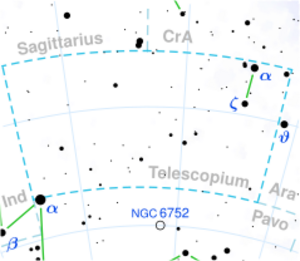Astronomy:Gliese 784
Coordinates: ![]() 20h 13m 53.396s, −45° 09′ 50.47″
20h 13m 53.396s, −45° 09′ 50.47″
| Observation data Equinox J2000.0]] (ICRS) | |
|---|---|
| Constellation | Telescopium |
| Right ascension | 20h 13m 53.396s[1] |
| Declination | −45° 09′ 50.47″[1] |
| Apparent magnitude (V) | 7.96[2] |
| Characteristics | |
| Spectral type | M0V[2] |
| B−V color index | 1.45[2] |
| Astrometry | |
| Radial velocity (Rv) | −33.5±0.5[1] km/s |
| Proper motion (μ) | RA: 778.331[1] mas/yr Dec.: -159.939[1] mas/yr |
| Parallax (π) | 162.2171 ± 0.0225[1] mas |
| Distance | 20.106 ± 0.003 ly (6.1646 ± 0.0009 pc) |
| Absolute magnitude (MV) | 9.01[3] |
| Details | |
| Mass | 0.58[4] M☉ |
| Radius | 0.58[5] R☉ |
| Luminosity | 0.06[5] L☉ |
| Temperature | 3,754±92[6] K |
| Metallicity [Fe/H] | −0.07±0.06[6] dex |
| Rotation | 48±12[7] |
| Rotational velocity (v sin i) | 1.0[2] km/s |
| Age | 0.85±0.4[8] Gyr |
| Other designations | |
| Database references | |
| SIMBAD | data |
Location of Gliese 784 in the constellation Telescopium | |
Gliese 784 is a single[8] red dwarf star located in the southern constellation of Telescopium that may host an exoplanetary companion. The star was catalogued in 1900, when it was included in the Cordoba Durchmusterung (CD) by John M. Thome with the designation CD−45 13677.[10] It is too faint to be viewed with the naked eye, having an apparent visual magnitude of 7.96.[2] Gliese 784 is located at a distance of 20.1 light-years from the Sun as determined from parallax measurements, and is drifting closer with a radial velocity of −33.5 km/s.[1] The system is predicted to come as close as 11.4 light-years in ~121,700 years time.[11]
This is a small M-type main-sequence star with a stellar classification of M0V.[2] It is much younger than Sun at 0.85±0.4 billion years.[8] Despite this, it appears to be rotating slowly with a period of roughly 48 days.[7] The star has 58% of the mass and 58% of the radius of the Sun. It is radiating just 6%[5] of the luminosity of the Sun from its photosphere at an effective temperature of 3,754 K.[6]
Planetary system
In June 2019 one planet candidate was reported in orbit around Gliese 784.[12] Since 2020, the star is suspected to be surrounded by a disk of cold dust, but the signal may be also due to a background extragalactic source.[13]
| Companion (in order from star) |
Mass | Semimajor axis (AU) |
Orbital period (days) |
Eccentricity | Inclination | Radius |
|---|---|---|---|---|---|---|
| b (unconfirmed) | 9.4+4.6 −4.1 M⊕ |
0.059 ± 0.006 | 6.6592+0.0033 −0.0038 |
0.05+0.23 −0.05 |
— | — |
References
- ↑ 1.0 1.1 1.2 1.3 1.4 1.5 Brown, A. G. A. (2021). "Gaia Early Data Release 3: Summary of the contents and survey properties". Astronomy & Astrophysics 649: A1. doi:10.1051/0004-6361/202039657. Bibcode: 2021A&A...649A...1G. 6673000841376349696 Gaia EDR3 record for this source at VizieR.
- ↑ 2.0 2.1 2.2 2.3 2.4 2.5 Torres, C. A. O. et al. (December 2006). "Search for associations containing young stars (SACY). I. Sample and searching method". Astronomy and Astrophysics 460 (3): 695–708. doi:10.1051/0004-6361:20065602. Bibcode: 2006A&A...460..695T.
- ↑ Anderson, E.; Francis, Ch. (2012). "XHIP: An extended hipparcos compilation". Astronomy Letters 38 (5): 331. doi:10.1134/S1063773712050015. Bibcode: 2012AstL...38..331A.
- ↑ "The One Hundred Nearest Star Systems". Research Consortium On Nearby Stars. January 1, 2012. http://www.recons.org/TOP100.posted.htm.
- ↑ 5.0 5.1 5.2 Gáspár, András et al. (2016). "The Correlation between Metallicity and Debris Disk Mass". The Astrophysical Journal 826 (2): 171. doi:10.3847/0004-637X/826/2/171. Bibcode: 2016ApJ...826..171G.
- ↑ 6.0 6.1 6.2 Hojjatpanah, S. et al. (2019). "Catalog for the ESPRESSO blind radial velocity exoplanet survey". Astronomy & Astrophysics 629: A80. doi:10.1051/0004-6361/201834729. Bibcode: 2019A&A...629A..80H.
- ↑ 7.0 7.1 Byrne, P. B.; Doyle, J. G. (January 1989). "Activity in late-type dwarfs. III. Chromospheric and transition region line fluxes for two dM stars". Astronomy and Astrophysics 208: 159–165. Bibcode: 1989A&A...208..159B.
- ↑ 8.0 8.1 8.2 Brems, Stefan S. et al. (2019), "Radial-velocity jitter of stars as a function of observational timescale and stellar age", Astronomy & Astrophysics 632: A37, doi:10.1051/0004-6361/201935520, Bibcode: 2019A&A...632A..37B
- ↑ "HD 191849". SIMBAD. Centre de données astronomiques de Strasbourg. http://simbad.u-strasbg.fr/simbad/sim-basic?Ident=HD+191849.
- ↑ "Cordoba Durchmusterung declination -42 to -52". Resultados del Observatorio Nacional Argentino 18: 1–502. 1900. Bibcode: 1900RNAO...18....1T. (See also 1900RNAO...18....1., 1900RNAO...18.....T). Page 206 (CD-45 13677)
- ↑ Bailer-Jones, C.A.L. et al. (2018). "New stellar encounters discovered in the second Gaia data release". Astronomy & Astrophysics 616: A37. doi:10.1051/0004-6361/201833456. Bibcode: 2018A&A...616A..37B.
- ↑ 12.0 12.1 Tuomi, M.; et al. (2019-06-11). "Frequency of planets orbiting M dwarfs in the Solar neighbourhood". arXiv:1906.04644v1 [astro-ph.EP].
- ↑ Tanner, Angelle et al. (2020), "Herschel Observations of Disks around Late-type Stars", Publications of the Astronomical Society of the Pacific 132 (1014): 084401, doi:10.1088/1538-3873/ab895f, Bibcode: 2020PASP..132h4401T
 |


